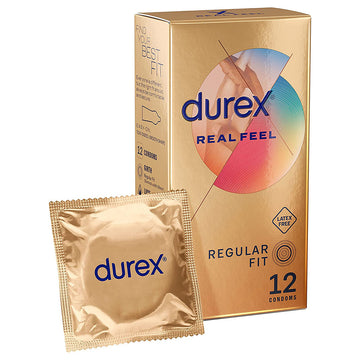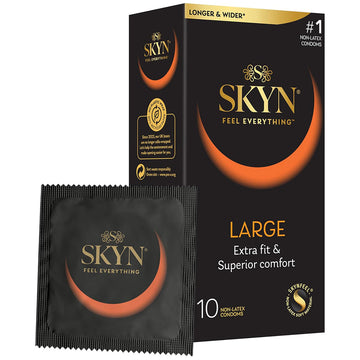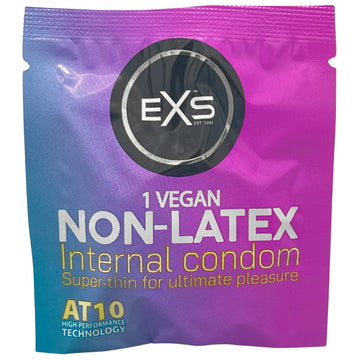Latex Allergy Condoms
What are latex allergy condoms?
Latex allergy condoms are condoms made from synthetic latex or non-latex materials. Synthetic latex is an umbrella term that refers to latex-like materials, including polyisoprene and polyurethane. Polyisoprene and polyurethane are two forms of synthetic rubber, but the condoms made of these materials have the same properties as latex condoms.
In fact, polyisoprene and polyurethane condoms are more elastic than natural rubber latex and feel very smooth on the skin.
Due to their higher elasticity, both polyisoprene and polyurethane condoms are often thinner than latex condoms. For this reason, many people use them despite having no allergy. The only downside of these condoms is their higher price.
Other condoms in the non-latex category are lambskin condoms. Like you could imagine, they’re made of lamb or sheepskin. These condoms are an excellent choice for those who want to use condoms made of natural materials, but they are obviously unsuitable for vegans.
What are non-latex condoms made of?
Non-latex condoms can be made of polyisoprene, polyurethane, or lambskin.
- Polyisoprene condoms: Are the main alternative to latex condoms. Polyisoprene is a synthetic type of rubber that doesn’t contain the proteins that cause latex allergies. This material is more elastic than natural rubber latex; thus, most polyisoprene condoms are very thin. Polyisoprene condoms offer the same protection against pregnancy and sexually transmitted infections as latex condoms.
- Polyurethane condoms: Are made of very thin plastic. You can find male and female polyurethane condoms, both types sharing the same properties. The main downside of polyurethane is that it doesn’t fit as tightly as latex and is more likely to slip off during intercourse. This issue can be easily warded off by using female condoms. Nowadays, most companies have switched to polyisoprene for their male condom options. If you do want to give polyurethane condoms a try, you can still find them from Trojan.
- Lambskin condoms: Are made of sheep intestine and don’t contain proteins that can cause allergies. These condoms feel very smooth, and men who complain about latex or polyisoprene condoms may find these condoms more comfortable to wear. Lambskin condoms are an excellent choice for committed couples who are concerned about pregnancy. However, they don’t offer protection against sexually transmitted infections due to the porous holes in the material.
What is the difference between polyisoprene and polyurethane condoms?
The main difference between polyisoprene and polyurethane condoms is that the former is a synthetic type of latex, whilst the latter is a thin type of plastic.
Generally, polyisoprene condoms feel more like latex condoms. They are very stretchy and elastic. Their texture is smooth and soft. Polyisoprene condoms often feel more comfortable than latex condoms because they are thinner. The only downside is their higher cost – making polyisoprene condoms is more complex, thus the higher price for these latex free condoms.
Polyurethane condoms don’t cause any allergies, but they aren’t as flexible as polyisoprene condoms. Polyurethane is also less elastic than polyisoprene, and the condoms may feel like cling film wrapped around your penis.
That said, polyurethane condoms are as safe as latex and polyisoprene condoms if sized and used correctly. Remember that they slide off easier, so you should pay attention at all times to stay on the safe side.
Are lambskin condoms any good?
It depends on what you’re looking for. If you’re not concerned about sexually transmitted infections – you’re in a monogamist relationship and are sure your partner only has sex with you – lambskin condoms provide excellent protection against pregnancy.
Because lambskin condoms are made from actual sheep intestines, these condoms don’t have a standard thickness. However, the animal product condoms usually feel like a very thin glove and deliver natural sensations.
However, if you’re concerned about STDs, you shouldn’t use lambskin condoms. Whilst this material can prevent semen from reaching the womb, the tissue is porous and typically can’t stop bacteria and viruses from passing through. In this case, you should use a polyisoprene or polyurethane condom for better protection against STI transmission.
Do lambskin condoms smell?
Lambskin condoms have a characteristic smell, just like latex condoms do. Some people aren’t bothered about their smell at all, whilst others find it repulsive. But then, many people also find the smell of latex regular condoms repulsive. If you prefer fragrance free sex products, you might also like Aloe Vera lube.
If we were to make a list of lambskin condoms disadvantages, the smell would make it somewhere near the bottom. The main disadvantage of this type of condom is that they don’t offer protection against STDs. Another major drawback is their price – lambskin condoms tend to be the most expensive condoms to buy.
The sheep intestine isn’t as stretchy as latex or polyisoprene either. These condoms can break easily if you don’t size them right, leaving you exposed to the risk of accidental pregnancy, so they are not the best condoms to prevent pregnancy.
Last but not least, lambskin condoms look less aesthetic than other condoms because you’ll be able to see the sheep’s intestine details quite clearly. That said, these condoms biodegrade faster than all other types of condoms and offer the most intimate sensations, close to not wearing a condom.
How do I know that I’m allergic to latex?
There are many reasons to use non-latex condoms, but if you’re specifically looking for a hypoallergenic condom, you should first ensure that you’re allergic to latex.
Latex allergy is a very rare condition that affects less than 1 in 1,000 people in the UK. Its incidence is higher in certain people that are exposed to latex frequently. For instance, people wearing latex gloves (such as healthcare workers) or latex equipment as part of their job are more likely to develop an allergy.
Those prone to develop an allergy will likely become sensitive to latex before their symptoms get worse. Latex sensitivity has very mild symptoms, typically rashes at the contact point. If you are sensitive to latex, you may observe redness in your genital area as a sign of allergic reaction, where the condom has touched your skin.
Latex allergies - How to treat an allergic reaction
Latex allergy also manifests with skin redness, itchiness, rashes, and sometimes inflammation. Moderate symptoms become more systemic and are similar to all allergy symptoms. You may have a runny nose, watery eyes, cough, and sneeze.
Severe symptoms include breathing difficulty, wheezing (a high-pitched sound when you’re breathing), scratchy throat, hives spread throughout your body, dizziness, confusion, nausea, vomiting, a drop in blood pressure, confusion, rapid or weak pulse, and loss of consciousness.
In rare cases, latex allergy can lead to anaphylactic shock, which is a life-threatening condition.
If you notice skin redness and itchiness after using a condom, make sure you’re using the condom is not irritating you. The lack of lubrication or the use of ribbed and dotted condoms may cause irritation. Try adding more lubricant and switch to smooth texture condoms to rule out these causes. If the irritation persists, switch latex condoms with your favourite latex allergy condoms.
You can find more information about how to treat latex condom allergy symptoms in our blog.
What brands make non-latex condoms?
For decades, condom manufacturers have only focused on natural rubber latex condoms. In recent years, however, most brands started to manufacture latex allergy condoms, too. Here are a few of the most popular non-latex condom brands.
Durex
Durex is a staple in the latex condom world, but the brand has recently introduced Durex Real Feel, a non-latex condom made of polyisoprene. Apart from the difference in materials, Durex Real Feel maintains the characteristics that have made the brand popular in the first place.
These condoms have a nominal width of 56mm – Durex’s standard size, but that suits men who need a slightly larger condom. The anatomical shape and easy-on design make these Durex latex free condoms very comfortable to wear.
SKYN
SKYN is perhaps the most popular brand of non-latex condoms. All options from the brand are made of polyisoprene. The main advantage of SKYN condoms is that you can choose from a wide range of options and several sizes of male condoms.
- SKYN Original: Are the standard condoms from the brand. They have a nominal width of 53mm and are 180mm long.
- SKYN Elite: They have the same nominal width as SKYN Original but are slightly longer (185mm). These condoms are about 20% thinner than the Original (0.05mm thick) and deliver more natural sensations. SKYN Elite condoms are ultra-soft and incredibly pleasant to the touch.
- SKYN Extra Lube: These condoms are the same as SKYN Original, but they are extra lubricated for added slickness and easier glide. They are compatible with silicone-based and water-based lubricants in case you want to add even more lubricant.
- SKYN Intense Feel: If you’d like to surprise your partner with a special condom, try SKYN Intense Feel. These dotted condoms have the pattern scattered across the shaft length and enhance vaginal and anal stimulation, so they are one of the most pleasurable condoms for women. The interior of the condom is smooth, so the texture won’t bother or irritate you.
- SKYN Large: Designed for a comfortable fit, these condoms are as large as Durex Real Feel. They have a nominal width of 56mm – all other options from SKYN are 53mm wide – and are 200mm long. With a nominal thickness of 0.065mm, they’re thin enough to allow for natural sensations yet thick enough to use for all kinds of sex in all peace of mind.
Pasante
Pasante is another brand known for its premium latex condoms, but people with latex allergies can also enjoy their products. Pasante makes two types of polyisoprene condoms.
- Pasante Sensiva: Suitable for people who need a large size condom, Pasante Sensiva has a nominal width of 58mm and is 180mm long. With a thickness of only 0.028mm, these condoms feel like a second skin and allow you to feel most of your partner.
- Pasante Unique: Larger than Sensiva, Pasante Unique condoms have a nominal width of 60mm and are 190mm long. These condoms are thinner than Sensiva (0.015mm) and allow for the most natural sensations in the range of polyisoprene condoms.
Can I use latex allergy condoms even if I’m not allergic?
Of course, you can. In fact, latex allergy condoms have a number of advantages compared to the latex variety.
- Non-latex condoms are thinner: All non-latex condoms are thinner than the latex variety, but they provide the same protection (with the exception of lambskin condoms, which don’t protect against sexually transmitted infections). Needless to say, the thinner the sheath, the more enjoyable the sex, which is why people love the ultra thin condoms.
- Latex allergy condoms don’t smell and taste like latex: the synthetic material condoms could be a better option for safe oral sex.
- You can use oil lubricants with polyurethane condoms: Because polyurethane is a type of plastic, the material won’t be damaged by massage or intimate oils. You can even use them with body lotions and creams without worrying that the product will alter its structure. However, you should never use oil based lubricants, silicone lubricant or petroleum-based products with polyisoprene condoms because they might break. Always check whether anal lube or whichever lube you are using is safe to use with the condom materials you choose.
- Non-latex condoms conduct heat better: Another great advantage is that non-latex condoms conduct heat better and deliver more natural sensations. They allow you to feel more intimate sensations and improve safe sex quality.
What is the best lube for anal sex?
Safety is the most important priority when it comes to choosing condoms and lube. Choosing the right lube is essential for comfortable and pleasurable anal sex. You should avoid using a silicone based lube for anal sex, water based lubricants are a safer choice. Durex Play Sensual Massage 2 in 1 is one of the best lubes for anal sex.
How safe is a condom?
When used correctly, male condoms are 98% effective but there are other factors that will impact the effectiveness, such as the material, the type of lube used, the fit and how old they are. Read more about how safe condoms are and how to use them correctly.
Why should I buy latex allergy condoms from you?
Buying latex allergy condoms from Condoms.uk comes with numerous advantages:
- A wide range of genuine condoms: At Condoms.uk, we only stock genuine condoms sourced directly from brands or their suppliers here in the UK. You can find a wide range of condoms in all sizes, including textured and non-textured condoms. We also stock a variety of condom friendly lubricants as well as other accessories you can use to spice up your sex life.
- Discreet delivery: Don’t you just hate it when you meet acquaintances in the condom aisle? Protect your privacy and avoid all embarrassing moments. Buying condoms from us means you’ll get your orders delivered in discreet, non-branded packaging. Our envelopes and boxes will make no reference to our website, condoms, sex toys, or other accessories, so you can rest assured nobody will know what you’ve ordered.
- Free nationwide delivery on orders over £25: We also offer free next-day delivery on eligible orders and can provide you with tracking numbers to know where your parcel is at all times.
- Subscribe & Save option: Aren’t you tired of running out of condoms? If you don’t want to give up a steamy night because you’ve run out of sheaths, subscribe to our service. We’ll deliver your condoms as frequently as you need, and you can opt out or change your settings at any time after the first two renewals.






















